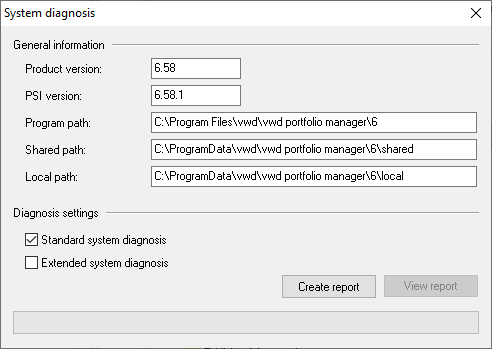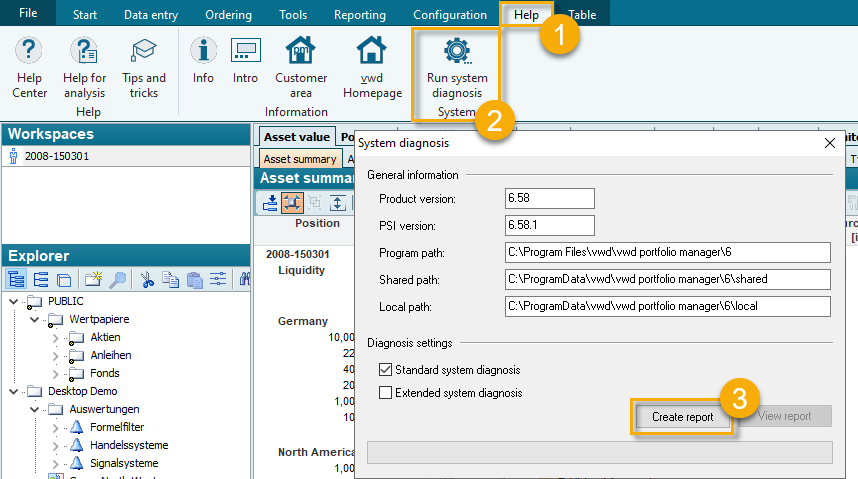System diagnostics
In the Infront Portfolio Manager you have the option of carrying out a system diagnosis. There are two different ways to start the system diagnostics:
Option 1:
- Select the <System Diagnostics> app in the Windows Start menu.
- Check the settings in the "System diagnostics" dialog box that appears.
- Start the system diagnostics with the "Create report" button.

- After the system diagnostics, the "Save as" dialog box appears in which you can select a directory and a name for the *.sdr system diagnostics file to be saved. Save the file with the "Save" button.
- You can then open the report using the "View report" button or close the "System diagnostics" dialog box using the close cross at the top right of the window title.
Option 2:
- In the ribbon of your Infront Portfolio Manager, select the "Run system diagnostics" icon on the "Help" tab.
- Check the settings in the "System diagnostics" dialog box that appears.
- Start the system diagnostics with the "Create report" button.

- After the system diagnostics, the "Save as" dialog box appears in which you can select a directory and a name for the *.sdr system diagnostics file to be saved. Save the file with the "Save" button.
- You can then open the report using the "View report" button or close the "System diagnostics" dialog box using the close cross at the top right of the window title.
You will find the following elements and information in the "System diagnostics" dialog box:
Element | Description |
|---|---|
Product version | The currently installed version of the Infront Portfolio Manager. |
PSI version | The currently installed version of |
Program path | The <Programm-Verzeichnis> with the program files, e.g. C:\Program Files\vwd\vwd portfolio manager\6. |
Shared path | The <Shared-Verzeichnis> with the database, e.g. C:\ProgramData\vwd\vwd portfolio manager\6\shared. |
Local path | The <Lokale Verzeichnis>, e.g. C:\ProgramData\vwd\vwd portfolio manager\6\local. |
Standard system diagnostics | In the "Diagnostic settings" area, you have the option of defining the scope of the system diagnostics. The standard system diagnosis provides the most important information about the installation and is a helpful function for Customer Service, for example. Deactivate the "Standard system diagnostics" checkbox, which is activated by default, if you do not want to perform this. |
Extended system diagnostics | The extended system diagnostics provide more detailed information than the standard system diagnostics. The results are evaluated further, access rights and registry entries as well as the database connection are checked, etc. The extended System diagnostics can be useful directly after installing the program, for example. Activate the "Extended system diagnostics" checkbox, which is deactivated by default, if you want to perform this. |
Create report | Once you have made or checked your settings, select this button to create a system diagnostics report. |
View report | If you have created a system diagnostics report, you can open the report using this button. |
